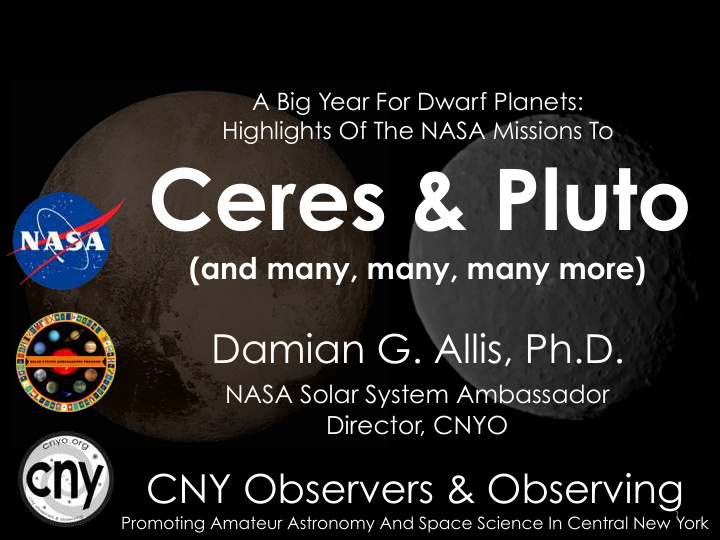



A Big Year For Dwarf Planets: Highlights Of The NASA Missions To Ceres & Pluto (and many, many, many more) Damian G. Allis, Ph.D. NASA Solar System Ambassador Director, CNYO CNY Observers & Observing 1 Promoting Amateur Astronomy And Space Science In Central New York
Ceres & Pluto (and many, many, many more) Damian G. Allis, Ph.D. NASA Solar System Ambassador Dept. of Chemistry, Syracuse University CNY Observers & Observing 2 Promoting Amateur Astronomy And Space Science In Central New York
The Next Hour Or So • Solar System Refresher • Ceres – The Planet That Couldn’t • Dawn @ Ceres • Pluto – The Planet That Ain’t • New Horizons @ Pluto • “The Lollipop Guild” • Final Thoughts 3
Sloan Digital Sky Survey
PNSA “A RELATION BETWEEN DISTANCE AND RADIAL VELOCITY AMONG EXTRA-GALACTIC NEBULAE” PNAS, Vol. 15, No. 3, 1929
Sloan Digital Sky Survey
9 map.gsfc.nasa.gov/m_ig/030644/030644.html
en.wikipedia.org/wiki/Observable_universe
en.wikipedia.org/wiki/Observable_universe
M31 (and M32 and M110)
en.wikipedia.org/wiki/Observable_universe
Astrophysical Journal, Vol. 801, pg. 105, 2015
en.wikipedia.org/wiki/Observable_universe
http://www.universetoday.com/32522/oort-cloud/ 18 https://en.wikipedia.org/wiki/Oort_cloud
en.wikipedia.org/wiki/Observable_universe
20 http://www.paulschow.com/2013/03/us-sized-scale-model-solar-system.html
21
Ceres (and the Asteroid Belt) 22
www.nature.com/nature/journal/v505/n7485/full/nature12908.html 23
24 www.nasa.gov/mission_pages/spitzer/news/spitzervega20130108.html
“Nearly Empty” • Total Composition = 4% The Moon • 1 km-Sized Objects = 8 Earth-Moon • Separations (on average) Carbonaceous, Silicate, and • Metallic Compositions Key Players – Ceres , Vesta , Pallas, • Hygiea, Eros, Ida… 25
26 http://www.universetoday.com/32856/asteroid-belt/
Ceres Background: Fr. Giuseppe Piazzi, 1 January 1801 Palermo, Italy Thought is was a planet, but then… “Binocular Object” Orbital Period: 4.6 yr Synodic Period: 1.3 yr 27
https://en.wikipedia.org/wiki/Ceres_%28dwarf_planet%29 28
https://en.wikipedia.org/wiki/Ceres_%28dwarf_planet%29 29
30
31 https://www.youtube.com/watch?v=wVL0ZvKKoUE
Dawn Mission 32
33
34
Mission Details: Launch – 27 Sept 2007 Arrival @ Vesta – 16 July 2011 Arrival @ Ceres – 6 March 2015 End-Of-Line – Permanent Orbit 35 www.rocketstem.org/2015/03/01/exploring-the-dawn-of-the-solar-system/
36
What We Know 37
38 http://www.space.com/22891-ceres-dwarf-planet.html
39
40
Pluto 41
Pluto Background: Clyde Tombaugh, 18 February 1930 Lowell Observatory, Flagstaff AZ “Big Scope Object” ry ry Orbital Period: 248 yr Synodic Period: 367 dy 42
Odd Orbit 43
What Makes A Planet? Orbit the Sun Spherical Shape (from gravity) “Cleared the neighborhood” of its orbit http://www.universetoday.com/13573/why-pluto-is-no-longer-a-planet/ 44
Not all That (other objects) 45
After Demotion (Hubble) 46 www.nasa.gov/images/content/571868main_i1123ay.jpg
47
www.wired.com/2015/07/pluto-new-horizons/ 48
49
What We Know 50 www.youtube.com/watch?v=mfQq2b4VT84
51
Geology 52 Announced 20 Nov, pluto.jhuapl.edu/
Clyde On The Ride 53
Many, Many, Many More… 54
134340 Pluto , a dwarf planet (225088) 2007 OR10 the largest object in the Solar System without a name (15760) 1992 QB1 , the prototype cubewano, the first Kuiper belt object discovered after Pluto 1998 WW31 , the first binary Kuiper belt object discovered after Pluto 79360 Sila–Nunam , another binary Kuiper belt planet with similar both parts (47171) 1999 TC36 , almost triple Kuiper belt (15874) 1996 TL66 , the first object to be identified as a scattered disc object (48639) 1995 TL8 has a very large satellite (385185) 1993 RO , the next plutino discovered after Pluto 20000 Varuna and 50000 Quaoar , large cubewanos 90482 Orcus and 28978 Ixion , large plutinos 90377 Sedna , a distant object, proposed for a new category named extended scattered Mostest Distant Yet (Until the next one) disc (E-SDO), detached objects , distant detached objects (DDO) or scattered-extended in the formal classification by DES 120347 Salacia , large cubewano with a large moon 136108 Haumea , a dwarf planet, the fourth-largest known trans-Neptunian object. Notable for its two known satellites and unusually short rotation period (3.9 h). 136199 Eris , a dwarf planet, a scattered disc object, and currently the most massive known trans-Neptunian object. It has one known satellite, Dysnomia. 1 36472 Makemake , a dwarf planet, a cubewano, and the third-largest known trans- Neptunian object 2004 XR190 , a scattered disc object following a highly inclined but nearly circular orbit (87269) 2000 OO67 and (148209) 2000 CR105 , remarkable for their eccentric 2008 KV42 , the first retrograde TNO, having an orbital inclination of i = 104° 2012 VP113 , a likely dwarf planet with the greatest perihelion of any known TNO 55 V774104 , at ~103 AU the currently most distant observable TNO, based on discoveries up to scitechdaily.com/distant-dwarf-planet-discovered-beyond-known-edge-solar-system/
Final Thoughts • Earth’s Rotation At 43 o North – 1500 km/hour • Earth’s Motion Around Sun – 107,000 km/hour • Sun’s Motion In Milky Way – 792,000 km/hour • Milky Way In “The Universe” – 1,987,200 km/hour • Sitting Here – 2,887,700 km (around the Earth 72 times) • 56
www.cnyo.org info@cnyo.org (facebook, twitter, google, youtube) Ceres & Pluto (and many, many, many more) Damian G. Allis, Ph.D. NASA Solar System Ambassador Dept. of Chemistry, Syracuse University CNY Observers & Observing 57 Promoting Amateur Astronomy And Space Science In Central New York
Recommend
More recommend